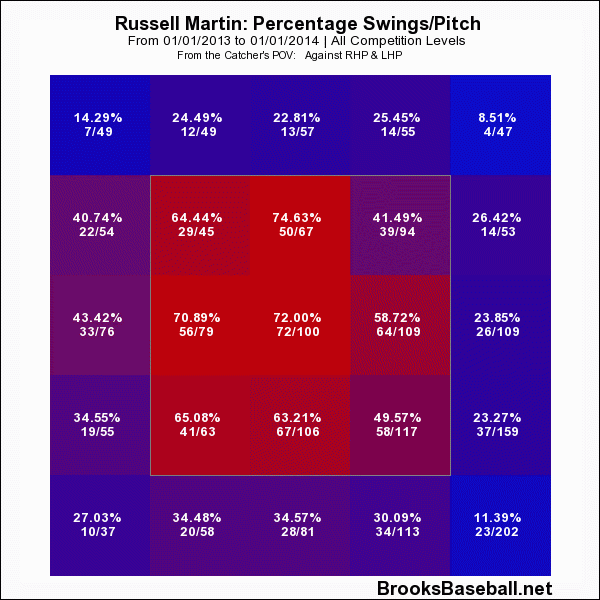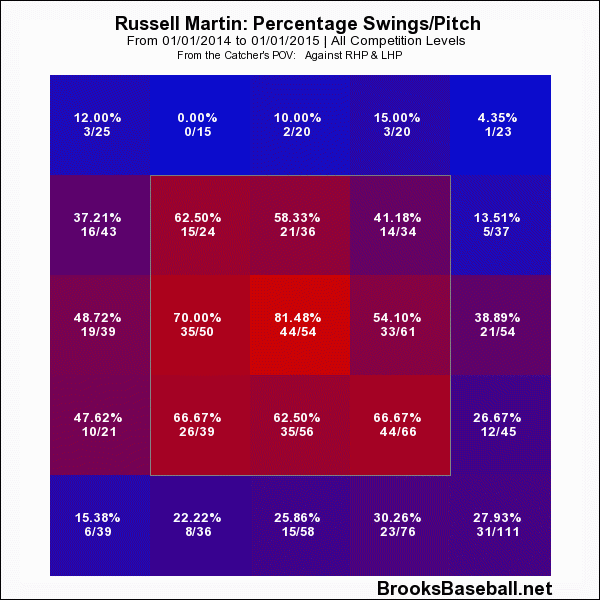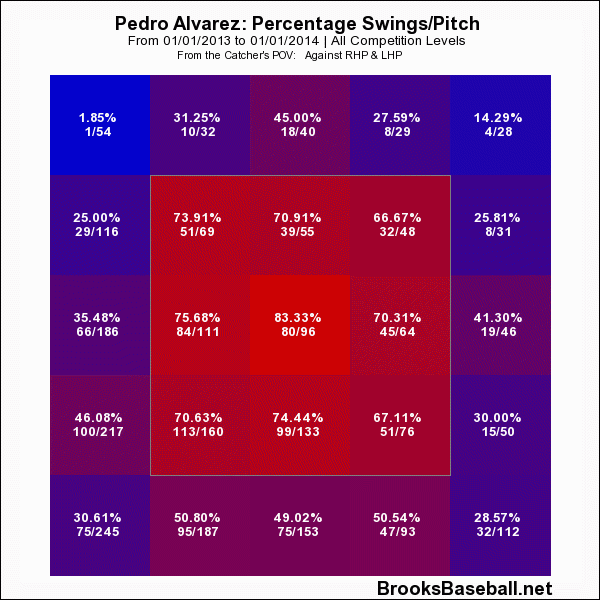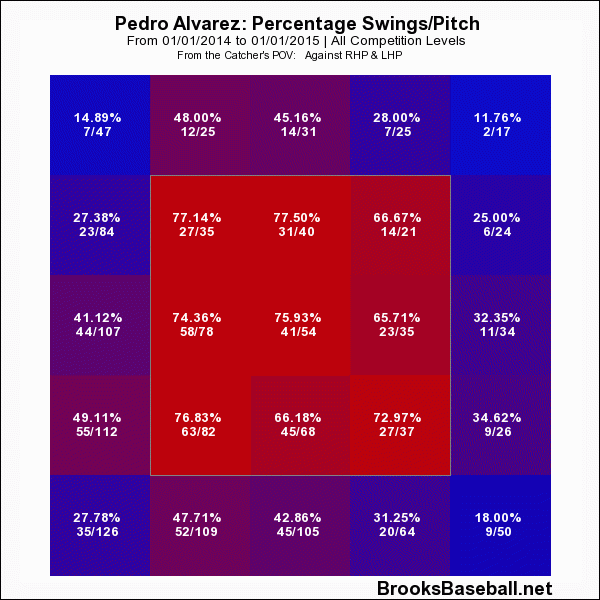The Pirates’ offensive turnaround this year has been a big topic of discussion lately. You likely know the basics. They’re fourth in the National League in runs scored despite playing in a pitcher-friendly park, their position players have a 110 OPS+, and their on-base percentage of .334 is the best in all of baseball. As you might expect, it’s awfully rare for a National League team to lead Major League Baseball in on-base percentage; since 2000, the 2012 Cardinals are the only NL team to pull off the feat.
This turnaround is really interesting to me, if only because I wouldn’t have predicted the Pirates to be an OBP-driven team even four months ago. In fact, I remember chuckling to myself when Nate Barnes wrote his story at Pirates Prospects in late April about the Pirates’ increased focus on good plate appearances and on-base percentage this year. That’s not to say I was laughing at Nate; just that saying, “We’re going to have better plate appearances this year,” is a boilerplate line and given the way the Pirates hit in 2013, I didn’t think that’s where the club was headed. The 2013 Pirates were basically an all-or-nothing affair. They were eighth in the NL in OBP last year, but they were third in home runs, which let them finish 9th in the league in runs, despite bad splits with runners in scoring position. Ninth in the NL in runs scored isn’t a bad result for a team that plays in PNC Park, but, well, ninth in runs scored is ninth in runs scored. Coming into this year, I figured that if the Pirates’ offense were to improve enough to be considered “good,” it’d be a variation on last year’s bombs-away approach.
Instead it’s happening much differently than I’d expected, and I’d argue it’s happened pretty quietly, too. There are really only three Pirate regulars having huge seasons at the plate this year. Andrew McCutchen (173 wRC+ — please go here for an explanation of wRC+ as a stat) is obviously one of them, and after him there’s Neil Walker and his power surge (135 wRC+), and Russell Martin and his .407 OBP (134 wRC+). What’s more important is that there’s not really anyone having a bad season, either. If you move down the wRC+ list on the club after the big three, there’s Josh Harrison (115), Pedro Alvarez (108), Starling Marte (105), Travis Snider (103), Ike Davis (103), Gaby Sanchez (102), and Gregory Polanco (99). Only Jordy Mercer (75) stands apart, and much of that is due to his pitiful start to the season. Even he’s hitting .278/.319/.409 in his last 65 games, which is a fine triple-slash line for a solid defensive shortstop.
What’s particularly interesting in that run of slightly-above-average hitters is that I think most Pirate fans would consider both Pedro Alvarez and Ike Davis to be having bad years, but both of them are relatively productive thanks to their OBP. Davis is legitimately on base quite a bit with his .349 rate, and Alvarez is at a respectable-and-career-high .326 clip. Even Starling Marte has been somewhat saved by his plate discipline this year. His .328 OBP is lower than last year’s .343, but he’s also gotten there without having to get hit with quite as many pitches as he did last year (he’s second in the league with 11 HBP in his 86 games, but last year he got hit 24 times in 135 games, but then, I guess he’s also on the disabled list with an HBP-caused concussion). Going back to that Nate Barnes story (which he recently followed up on), I started thinking about the Pirates’ walk rates this year.
As you might guess, more than half of the Pirates’ carryover starting lineup has increased their walk rate this year. Russell Martin’s unexpected .407 OBP is partially a product of BABIP, but his walk rate is also 12.7% this year, up from 11.5% last year (all walk rates are from FanGraphs’ individual player pages). Starling Marte is up from 4.4% to 6.6%, Andrew McCutchen is up from 11.6% to 13.9%, Pedro Alvarez is up from 7.8% to 11.0% and even Josh Harrison is up from 2.1% to 5.3%. Throw in Ike Davis, who’s slightly down from last year but still walking at a 14.8% clip with the Bucs, and Gregory Polanco, whose last year isn’t really applicable but who is walking at an 11.2% rate right now, and, well, you can see where the focus on plate discipline is paying off for the Pirates.
Of course, seeing these moving walk rates makes me curious. What does improved plate discipline look like? Is it really something that Clint Hurdle and Jeff Branson have taught Pirate hitters? You can explain a bunch of these increases in walk rate without struggling too much. Starling Marte is young and his plate discipline is improving every year. Andrew McCutchen is obviously going to get pitched around more. Josh Harrison is playing regularly and pinch-hitting less. Still, Russell Martin’s walk rate is as high as it’s been since 2008, and Pedro Alvarez displaying something that could be construed as plate discipline is notable. I think those two are a good place to study the Pirates’ evolving approach at the plate.
We’ll look at this using Brooks Baseball‘s PitchFX graphs for hitters, and we’ll use the swing rate heat maps from 2013 and 2014 for Martin and Alvarez. Let’s start with Martin — 20013 swing rates first, then 2014 (the pictures link back to the original pages at Brooks).
I’m always hesitant about these 2D representations of the three-dimensional strike zone, but it looks like Martin’s improved in a few places with the area above the strike zone really standing out. Last year Martin swung at 20-25% of pitches over the plate, but above the strike zone. This year, he’s swung at 5 of 45. He’s improved slightly on low pitches, too, and he still loves to hack at pitches inside and off the plate, but it seems to me like he’s clearly made an effort with high pitches and that that’s probably where the difference comes in.
Let’s move on to Alvarez: 2013 first, then 2014 (images link back).
Same 2D vs. 3D caveat applies, but I think you can see Alvarez is making a much better effort on inside pitches this year. In particular, he hasn’t gone fishing nearly as much for low and inside pitches (the two bottom-right-most boxes). He obviously still swings way, way too much (compared his out-of-zone percentages with Martin’s) and has plenty of weak points, but again, I think you can see a places where he’s made a concerted effort to improve.
There is, of course, a larger conversation to be had here. The Pirates’ improved plate approach is impressive, but, at least in Alvarez’s case, it’s come at the price of some of the team power. Obviously this is noticeable; the Pirates are better at getting runners on base than any team in the baseball, but they’re not leading even the NL in run-scoring. They also lead the National League in runners left on base by a healthy margin. That’s a tricky road to walk down since having more runners on base will lead to more runners left on, but I think it’s obvious the Pirates have some efficiency struggles on offense.
Still, I think it’s also clear that this year’s offense is more dynamic than last year’s because of the depth that their improved OBPs has created. I’ve noted a few times in the past that hitting coaches seem like baseball’s favorite scapegoats — both by the fans and by upper management. I think something like 25% of the non-playoff hitting coaches were fired immediately after the season ended last year, and that’s something that happens pretty much every year. That means that it’s absolutely worth giving Jeff Branson and Clint Hurdle (who was a hitting coach in the past and obviously does plenty of work with the hitters) their due here. The Pirates’ offense is better this year and while part of that is simply due to having better players in 2014, part of it is also because the team has succeeded in helping their hitters change their approaches enough to shift the team’s on-base percentage upwards noticeably.
Top image credit: Dan Gaken, Flickr
























